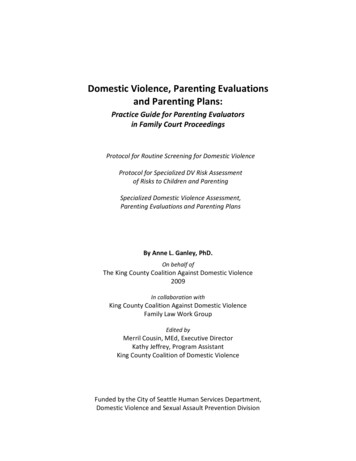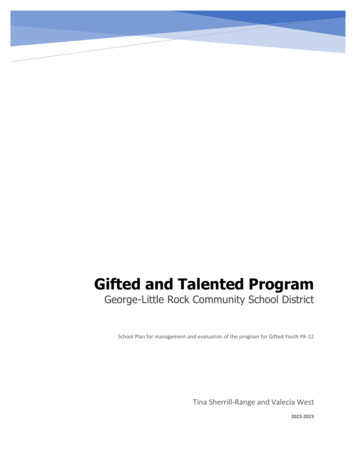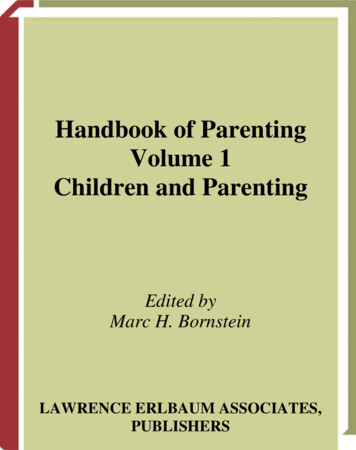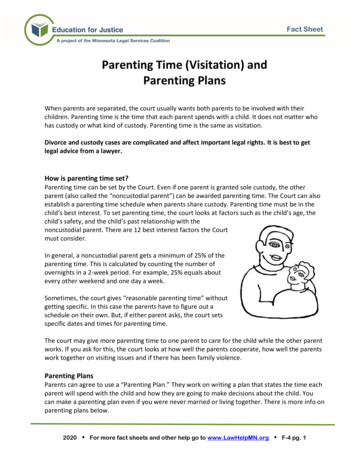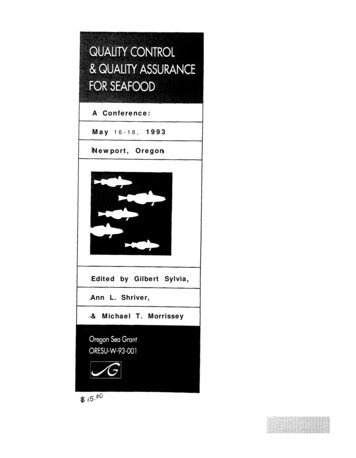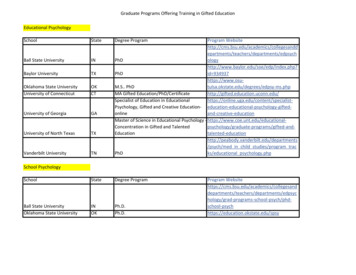
Transcription
DOCOMERT BERMEED 185 715EC 123 525AUTHORTITLE ,Wood,SamellynParenting Gifted Children. Oregon Series on Talentedand Gifted Education.INSTITUTION Northwest Regional Educational Lab., Portland, Oreg.;Oregon State Dept. of. Education, Salem. Office ofTalented. and Gifted Education.SPONS AGENCYOffice of Education (DHEW) , Washington, D.C. 79PUB DATE'GRANTG007900756NOTE .30p.; For related information, see EC 123 522-531.AVAILABLE FROM Office of Marketing, Northwest Regional Educat .onalLaboratory, 7 10 S.W. 2nd Ave., Portland, OR ,97204( 2.95 each: 26.55 for the full set)EDRS PRICE'DESCRIPTORSMF01 Plus Postage. PC Not Available from 'EDRS.*Child bevelopment: *Child Rearing; EmeticnalDevelopment: *Gifted: Moral Development; *ParentRole: Social Development: *TalentABSTRACTPart of a 10 booklet series on talented and giftededucation, the booklet discusses the parenting cf gifted and talentedchildren. Some myths and realities about giftedness are examined,.along with differences and similarities between gifted and otherchildren. The nurturance and broadening of children who afire giftedintellectually, in the visual and performing arts, and in physicaldevelopment are considered. The emotional development of giftedchildren is defined, and basic stages 'of growth are "outlined,including trust, autonomy, initiative, and testing rules andrelationships. Social development is discussed in terms of understanding individual style, peer groups, social growthindicators, and ways to support growth. Motal growth is described interms of inner controls, values and decisions, and parental guidanceand expectations. Techniques and notes of assurance axe presented onproviding experiences for gifted children which fully develop theirintellect, emotions, social sensibility, and morals. Lists ofsuggested readings and sources cf information on talented and giftedchildren are also given. (DLs)
Parenting Gifted Chi
PARENTING GIFTED CHILDRENSamellyn Wood 'This series was cooperatively developed by thefollowing: Project Director - Robert Siewert,Specialist , Talented and Gifted Programs, Oregon'Department of Education, Sálem, Oregon; ProjectCoordinator Carleen Matthews, Northwest RegionalEducational Laboratory; Series Editor - CandyWithycombe; and Richard Arends, University of Oregon.OregonAssociation forTalentedAndGiftedOregon StateNorthwestDEPARTMENT RegionalOF EDUCATION. EducationalLaboratory
Copyright c by the Oregon Department of Education, 1979.The "Oregon Series on Talented, and Gifted Education" ofwhich this booklet' is a part, was made possible withthe support of the United States Office of Education,., Department of Health,' Education and Welfare, throughgrant MG007800756 to the Oregon Department ofEducation, Office oe Talented and Gifted Education.'However, the content does not necessarily Tefleçt- theposition or policy of HEW, and no official endorsementof these materials should inferred.The Northwest Regional Educational Laboratory, undercontract with the Oregon Department of Education,provided technical assistance in the development of theseries and was granted license to publish the materialsfor nationwide distribution.All rights reserved. No part of this booklet may be reproduçed in any form or by any means without.permission in writing from the copyright holder.STATEMENT OF ASSURANCEIt is the policy of these agencies, that no person besubjected to discrimination on the basis of race,national origin, religion, sex,age, handicap, ormarital status in'any program, service,, or activity forwhich these agencies 'are responsible. They will complywith the requirements of state and federal lawsconcerning nondiscrimination and wilt strive. by their.actions to enhance the dignity and worth of all persons.
ABOUT THE AUTHORSDr. Fay Haisley is a professor in the Department ofEducation at the University of Oregon and has beeninstrumental in organizing' the University- of'Oregonmasters program in gifted education.George Wilhelmi has previously .worked in giftededucation in Connecticut-and is presently the headteacher in the P.A.C.E. Program for the talented andgifted in the Eugene School District, Eugene, Oregon.' Richard Bagley,'kennetlh Frazee., Jean Hosey, James ,Kononen, Jan Speci al"e and Doris Woodfield were participants in the Summer Institute on Talented andGifted Education in Monmouth, Oregon, sponsored by theOregon Department of Education during the summer of1978. All are teachers either directly involved in the*instruction of talented and gifted children or are.involved in.organizing programs in-their districts,Sandra HowelÍ has a long, association with giftededucation in Oregon. Once a teaching assistant withElizebeth Monroe Drews and Portland State University,Sandra is now the pxoject director for M.A.C.E.,'aTitle IV C proj.ect for 'talented and gifted children.Alfreda Ebeling has training and-experience in thefield of counseling;- and, as a mother of giftedchildren, has experienced the problems and approachesfor parental counselingAlfreda is presently a freelance writer and consultant.Kendra Morberg has her M.S.'in gifted education fromthe University of Oregon and is presently,teaching,primary grade talented and gifted children. .Kendraalso participated in the State Task Force ón EarlyIdentification and Programming for. Gifted Childrenduring 1978-79 and co-authored the Task Force report.
Samellyn Wood is presently conducting workshops andclasses in Oregon on parenting talented and giftedchildren, and is a co-author of Four, Styles ofParenting .Gail Horner and Sue Rits are parents of giftedchildren, are officers in the Oregon Association foxTalented and Gifted, and are actively involved insupporting school programs for talented and giftedchildren.Veronica Boeholt is a member of the steering committeefor the talented and gifted program in the districtwhere she teaches. She is-actively involved in theOregon Association for Talented and Gifted, and wasamong the original organizers for this state wideassociation.,r Jackie Buisman is one of the originators of the OregonAssociation for Talented and Gifted and served as theorganization's president in 1978-79. Jackie ispresently a teacher of intermediate grade talented andgifted children, and is the mother of a gifted child.Special thanks to the following reviewers whocontributed helpful suggestions.Gayle Hendrick. Nancy LeahyLinda ContrerasRonald SmithPatricia PintarachBeaverton, OregonGladstone, OregonSacramento, CaliforniaPortland, OregonPortland, OregonIllustrated by:Sharon TorvickWarren SchlegelMaggie RogersSalem, OregonPortland, OregonPortland, Oregon
FOREWORDThis booklet describes myths and realities aboutgiftedness and the needs'for nurturance and broadeningof the gifted child.'Emotional development is defined, basic stages ofgrowth are given, and from these descriptions, parentscan select, the most, appropriate parenting.techniquesfor those staSes.Soci'al development, individual styles, peer groups andsocial growth indicators are described to help, parentssupport growth in this area.Moral growth is described in terms of inner controls,values, and parental guidance and expectations.Parents are given techniques and assurance to provideexperiences for the gifted children which fully developtheir. intellect, emotions, social Sensibility andmorals.
TABLE OF CONTENTSvFOREWORDMYTHS AND REALITIES ABOUT GIFTEDNESS1NURTURANCE AND BROADENING OF THE GIFTED CHILD5EMOTIONAL.DEVELOPMENT: DEFINITION AND STAGES7SOCIAL DEVELOPMENT11MORAL GROWTH13THE BIG PICTURE17SUGGESTED READINGS21SOURCES OF INFORMATION25
Two mothers talked casually overcoffee. "You know Jimmy, that brainykid down the street? The skinny onewith the thick glasses? That kidread two sets of encyclopedias thissummer and he's just starting firstgrade!":"But the poor child can't catch aball or ride a bicycle. He must havea terrible complex. The other kidsmake such fun of him."
MYTHS AND REALITIES ABOUT GIFTEDNESS 'MYTHSJimmy is the mythical gifted child; not many peopleknow him. Real gifted children may be like him in somerespects, but usurally'they are physically strong andhealthy: Many read early with intense curiosity and remarkable comprehension of idea's., but some giftedlate into primarychildren may' not learn to read untilschool.- A few 'may be withdrawn, bqt more often theyaré leaders. Gifted children are not necessarily'gifted in all areas. However, they'frequently havemultiple gifts. Fine athletes are often excellentstudents; briIliant mathematicians are oftenaccomplished musicians.The myth of the gifted child has developed for areason. There are gifted children whose families havedevoted their full time and energy to the development of Et particular talent, to the exclusion of activitiesin other areas. These children have actually beenhandicapped by their lack of exposure to a broad rangeof experiences and'ideas.FULL HUMAN DEVELOPMENTDevelopment of children's special gifts need to occurin"connection with full development in all other areas,if these children are to attain their potential forboth achievement and joy. The areas includeintellectual, aesthetic, physical, 4motional, socialand moral spheres.
Intellectual and aesthetic matúrity'encouragesthe development of startling achievements,inventions and creations.Physical maturity supports a positive bodyimage, confidence in self, health and energy foractive participation in-life's experiences.Emotional maturity provides the confidence toseek out challenges, learn from mistakes andrespond to new experiences with an open, eagerspirit.Social maturity supports the capacity toestablish good interpersonal and grouprelationships and the growth of independence.Moral maturity provides an understandirig'ofvalues and the ability to make wise decisions.DIFFERENCES AND SIMILARITIES BETWEEN GIFTED AND OTHERSGifted children have much in common with otherchildren, but they are different in important ways.Parents must recognize and provide for both thesimilarities and the differences. All children passthrough the same stages of growth, but the gifted maypass through some stages more quickly. All childrenneed to inquire, to explore, to analyze,, to synthesize,to create means of self-expression and to formulateconcepts that help them understand the world as theysee it. Gifted children need to inquire further, ,explore more boldly, analyze more deeply, synthesizemore fully, formulate concepts that are different andnew. While gifted children may be more advanced thantheir peers in one or two areas, they may well be onthe same level in others. They, too, lose theirtempers, laugh in delight, cry, giggle, whine andshout. They, too, need constant doses of love and'affection.
Many patents search for experiences, which will providetheir children with in-depth exploration, development'of special talents, wide exposure to many experiencesand development in all areas of human growth.
NURTURANCE AND BROADENINGOF THE GIFTED CHILDINTELLECTUAL GIFTEDNESSChildren who are intellectually gifted need a greatdeal of .stimulation 'for the tremendous learning ofwhich they are capable. They.can deal with abstractidea's in depth at an earlier age than can otherchildren; they require only the chance to léarn.Parents of the gifted are often willing to answer themyriad of questions their children pose. They discusspossible answers with them and help them furtherinvestigate ideas and principles through the use ofhome, school and community resources. In addition,parents ask the children many questions."What if we mixed these?""Why do you suppose it works that way?""How else could that be used?"The home environment may be designed to allow. development of special interests and to encodrage broad,exploration. Learning games and activities may beenjoyed by the whole family. .Scrap materials arestockpiled for a young engineer to build spaceships orseismographs. A budding scientist is helped throughobservation and simple experiments to discover and''describe many nptural laws.Intellectually gifted children also need encouragement". to explore academic areas where they may not be gifted.and will have to work harder for success. Writing may
. be Sara's forte, and she needs time and quiet places towrite', but she also needs math skills.GIFTEDNESS AND TALENT IN VISUAL ARTS,PERFORMING ARTS OR PHYSICAL DEVELOPMENTSimilarly, children with special abilities. in thevisual or performing arts or in psychomotor skills needthe opportunity to develop those abilities. A childgifted in mime needs to see others perform and toreceive encouragement and instruction in improving hisor her own performance. An enthusiastic preschoolmusician can begin Suzuki violin. A determined younggymnast can practice on a low, backyard balance beam.These children need broadening experiences too. . Atalented.swimmer needs frequent practice and coachingbut also needs to'vis i t theatres and. museums.GENERAL BROADENINGParents of the gifted can encourage their children'sfull growth in many ways. A gifted mechanic studiesFrench each night before going to "play" in her shop.The child who continually opts to sit with a thousandpiece puzzle is taken for nature walks where he soonlearns to identify plant and insect life with the sameenthusiasm he brings to his puzzles. The aspiringchemist who prefers her basement laboratory to allother places is guided in reading biographies of greatchemists, then other biógraphies, historical fiction,science fiction and drama.
EMOTIONAL DEVELOPMENT:DEFINITION AND STAGESThe'emotional development of gifted children supportstheir gifts. A strong sense of self-confidence andcompetence provides the impetus for these children toseek new information and master new skills without fearof failure. It also frees them to appreciate and'accept others both similar to and different.from them.Children pass through stages in their emotional growthjust as they do in other areas or growth. Parents can'thelp them in each stage so they can move suçces.fullyon to the next.TRUST.'First, children must establish a basic trust in boththemselves and the world around them. They need tolearn that when they cry out, others will respond to .them. Otherwise they will spend the rest of theirlives.trying to establish this trust.' Further growthis crippled by anxiety. When parents respond in aloving, consistent way to an infant this trust can beformed in the first two years of lifeAUTONOMYAutonomy becomes the next"ma?or task. Gifted. toddlersoften seem driven to prove "I can do." Their awarenessof the world around them and their-desire foraccomplishment can be so far beyond their .physical
capabilities that intense frustration results. Yeteven the strongest "no" and harshest punishment cannotalways stop a young child from learning what he or she'can do. Relentless experimentation finally results inthe opening of a child-proof bottle or thedisassembling of the kitchen blender. Some"giftedchildren appear almost hyperactive as.they dart fromstimulus to stimulus seeking to see,'to know and tounderstand. Others have a concentration span equal tóthat of the professional researcher. And close at handare weary parents wondering about the remotepossibility of a neat home and a semblance of organized'living. But if children's curiosity and drive forautonomy can be safely channeled rather than forbidden,a basic, sense of personal. identity, importance andmastery 'will be established.INITIATIVEA growing sense of initiative increases forays into theoutside world. Even when children spend most of theirtime with peers, the family is still their "safeharbor." Partnts provide the support that allowschildren to take initiative with confidence. Giftedchildren may need especially strong doses of acceptanceand reassurance when they meet peers or adults who do 'not understand them. When being "different" becomes'painful, they seek' home and family to .have their selfesteem recharged.TESTING RULES AND RELATIONSHIPSGifted adolescents fervently test and retest the rulesand relationships'in their lives. They have to, for-they must establish their independence before they cansecurely move into adult interdependent.relationships.If-párents can recognize the need for independence andself-understanding as a genuine growth need and not a
personal assault on family mémbers, they can learn to.help their children through this difficult period.Effective communication can bind the family together as'adolescents searçh for and discover their own identity ,.and place in the world.
SOCIAL DEVELOPMENTUNDERSTANDING INDIVIDUAL STYLESocial development brings additional dileimas. Manygifted children play happily with children of allabilities and interests and have a wide circle offriends. Others have only one or two. close friends.Parents worry that these children may be lonely or may be failing to develop needed social skills.'Their concern is legitimate. People need other people,physically, emotionally and intellectually. Butchildren differ in their social needs just as they doin other needs. Some children seem to need manyfriends, thriving on peer acceptance and opportunitiesto participate in, or lead groups. Bóbby wantsdesperately to be well-liked and feels competitionkeenly. It was wisely decided that he shouldn't skip agrade although he could easily do the work. Otherchildren are very happy with a few close friends.Julie is satisfied working alone or with her one closefriend in her accelerated program. .She accepts herselfand her performance with ease. Neither child ismaladjusted. they are simply different.PEER GROUPSChronological, age is only one criterion which may beused'in the establishment of a peer group. Childrencan alto be peers in mental age or interests so that a
child who consistently prefers older friends may stillbe socially comfortable and adept.SOCIAL GROWTH INDICATORSThé important guidelines of social development forparents tó observe are whether a child:Is sensitive to the needs of othersCan show appropriate concern for and responsesto othersUses words and behaviors which reflectconfidence and, comfort with othersHas a few close friendsWAYS TO SUPPORT GROWTHParents can provide early social opportunities througha playgroup for toddlers or a preschool experience forthree and four year olds. Neighborhood and schoolfriends can.be involved in interesting home projects ortaken with the family to a library, museum or zoo.Parental approval can do much to encourage buddingfriendships. Candidly expressed disapproval maydiscourage them. Listening to théir children can helpparents discover why some children consistently chooseto be alone. The problem may be resulting from a lackof shared interests with other childten. A child's owninsecurities or misbehaviors may be the root of thedifficulty. When parents understand the cause of thebehavior, they can often assist their children. For.example, Jenny needs help recognizing when she becomestoo bossy. Once she understands;'she may be welcomedby the new girl next door.
MORAL GROWTHMbral growth plays an essential role in supporting thefull development of gifted children. They need todevelop self-discipline, an understanding of personalvalues and an ability to make decisions.INNER CONTROLSGifted children, like all children, must develop asystem of inner controls. They are not born withacceptable behavior patterns and meins of expressingemotions; parents and others help them develop these.Too often bright children are expected to behave at thelevel of their, intellectual performance, but they arejust not ready. Unrealistic expectations lead to greatfrustrations for both parent and child. Mostarticulate two year olds still dissolve in tears whenanother toddlor takes a favorite toy. Often precociousthirteen year olds suffer painful adolescent selfdoubts.VALUES, DECISIONS AND THE GIFTEDGifted children need help exploring, understanding andoperating on their personal values. The intellectuallygifted, particularly, have the keen insight and powersof abstract reasoning when quite young to assesssituations and recognize their own position and powerwithrn them. Their ability,to analyze and synthesizeenablés them to see causes, consequences andinterrelationships. .They learn how things affect them-what makes them feel happy or unhappy, capable orignorant, satisfied or restless. And they learn how
things affect other people. They constantly seek toclarify their own values and the values of othersthrough examining experiences and ideas.PARENTAL GUIDANCE AND EXPECTATIONSConsequently, many gifted childreh do. not acceptauthority without question.' They demand fullexplanations for rules and requests; they scoff at"easy answers." When they consider explanations validthey readily cooperate. If they judge the explanationsinadequate, they are apt to choose their own course ofaction. The inexhaustible questioning and independentbehavior of many gifted children may thoroughly wearout their parents. However, as the parents continue tolisten and'respond to them, they model suchcharacteristics as patience, tolerance and acceptance-attributes most are eager for their children to valuearid adopt. Further, through open discussions they helptheir children clearly define personal values andoperationalize these values in a wide variety ofsituations. For example, through an activeinvestigation of many churches and religiousphilosophies, Charlene developed commitment to herfamily's religion as well as an appreciation for manyother belief systems.Similarly, children need parental guidance as theylearn to make decisions. Decision-making is not asimple question of choosing "right"'and "wrong."Children must learn to assess total situations, lookingat individual circumstances and examining motives,need?, background and behavior of the people involved,.as well as possible consequences of actions. They thenneed to evaluate all this information in relation totheir, personal values.Even gifted children are not born knowing it is wrongto pick the neighbor's.flowers without permission. All
, children first behave to please others. They thenformalize their behavior according to externallyimposed rules. As they mature they learn tointernalize the rules and modify them according toindividual circumstances and needs.Because gifted children can deal with abstract ideas atan early age they may go through stages of questioningand testing rules and values sooner and more vigorouslythan other children. With help they can learn to mikeexamined decis}ons.at an early age. Parents can givethem frequent choices and help them look at theconsequences of'their decisions. Family members cantell stories where children identify motives behindbehavior in a particular situatión and decide whatpossible courses of action the characters might take.Parents can ask mind teasers like:"Is it worse to steal ten cents or a dollar?Why?"'"What might someone else do if they were caughtshoplifting?""What, might you do? Why would you actdifferently?"Children, too, can generate these teasers. Family'problems can be solved through negotiations, with bothchildren and parents expressing their ideas, examiningalternative solutions and anticipated consequences.
THE BIG PICTUREPROVIDING 'FULL EXPERIENCESGrowth and learning in all areas of development can beencouraged and integrated through parents providingfull or total experidnces. Both parents at home andworking parents can give quality time to share suchexperiences with their children. A few minutes areenough to share meaningful love and ideas.During a trip to the zoo, parents and children canlearn together while they enjoy each other. Parentscan promote intellectual skills and imagination byasking such questions as:"Why mightthose different species of birds beplaced together?""Why is that cage constructed with those heavybeams?""Why does a zebra have stripes and a leopardhave spots?"Visual skills are practiced when children seek answersto questions like:"What markings do you see on the tortoise's.shell?""How does the tarantula move?"
Emotional' relationships can be considered:"How do you think that cub feels separated fromits mother?" ."Do you think the elephant on the left mindsbeing the smallest?"Social dimensions can,be explored:"Why do you think they've put all the rhesusmonkeys in óne cage?"Moral development, too, can be enhanced:What would you do if you were that sea otterand the keeper threw all the fish to the otherotter so you didn't get any?"Many full experiences can be created at home. Planning'and holding a backyard picnic provides opportunities totouch on every domain'of development. "Let's have apicnic in the backyard. Would you like to? What canwe prepare that' will make our picnic look as good as ittastes? What kinds of plants will we see on ourpicnic? Your little brother is ,asleep and can't comeright now. How will he feel if we have our picnicwithout him? .Is there avfriend close by you would liketo invite? Do you think your friend shoúld bringsomething to our picnic? Do you know people who neverget to go on picnics? Does it matter? What could youdo about that?"NOTES,OF ASSURANCEParenting is important' and rewarding, even though attimes it is frustrating or a bit overwhelming. The twomost important keys to gobd parenting are love and.understanding. These keys are much more important than
whether the family structure has a single parent or twoparents, or whether the parents are step-parents,adoptive parents or. natural parents. Love literally"carries a family through." Talks with other parentsof gifted children,,as well as parent education coursesand books, -can help parents -develop a betterunderstanding of their individual children and theparenting task: As parents learn about theirchildren's growth needs, and as they offer consistency,teliability, warmth and love,' they will support in avery natural way the healthiest development of theirgifted children.
SUGGESTED'READINGSBriggs, Dorothy Canfield. Your Child's Self-Esteem.New York: Doubleday and Co., Inc., 1970. Anexcellent, readable discussion of how a child'sself-esteem develops and can be enhanced by certainkinds of parenting.Burroughs, M.C. Restraints on Excellence: Our Waste ofGifted Children. Lewiston, Idaho: OrchardsPrinting, 1977. (Dept. M 1113 Burrell Avenue,I ewiston, Idaho 83501.) An excellent, readablebook on what gifted children are really like and.how they can best be helped to achieve trueexcellence.Delt, Jeanne L. and Ruth A. Martinson. The Gifted andTalented: A Handbook for Parents. Ventura County,California: Superintendent of Schools, Ventura'County. An excellent resource book developedespecially for parents of the gifted.Drews, Elizabeth. Learning Together: How to FosterCreativity, Self-Fulfillment and Social Awareness. in Today's Students and Teachers. Englewoodtlifts, New Jersey: 'Prentice-Hall, 1972. A beautiful book for the lay reader that suggestsmany ways children and adults can learn together.Erikson, Erik H. 'Childhood and Society. New York:N.M. Norton and Co., Inc. 1950. A classic butvery technical,study of social-emotional development
Gallagher, James J. Teaching the Gifted Child. NewJersey: Allyn and Bacon, 1975. A classic,,somewhat technical definition and discussion ofchar.açter-istics .and needs of the gifted.Goert2el, Victor and Mildred George. Cradles ofEminence: Boston, Massachusetts: Little, Brownand Co., 1962. Entertaining and revealing studiesof eminent people. Through discussions of theirparentage, education and early environment itprovides answers to many far-reaching andfundamental questions about creativity.Grost, Audrey. Genius in Residence. Néw York:Prentice-Hall, 1970. A thoroughly delightfulbiography of Michael Grost, a child prodigy.Khatena, Joe.' The Creatively Gifted Child:Suggestions for Parents and Teachers. New York:Vantage Press, 1978. A clear, useful book forworking with creatively gifted children.Lane, H. and M. Beauchamp, Understanding HumanDevelopment, Englewood Cliffs, New Jersey:.Prentice-H ll, Inc., 1954. Simple, cleardescriptions of development through adolescence.Piaget, Jean. The Moral 3udgmeht of a Child. 'New York:Free Press, 1932. A technical but understandablepresentation of Piaget's theory of moraldevelopment.Pickard, Phyllis M. If You Think Your Child Is Gifted.Hamden, Connecticut: Shoestring Press, 1976.Intended for parents of the giftedThe. book .provides information on gifted children through thecenturies, including assessment of intelligence,the value of art, parents' roles and future trends.
Renzulli, Joseph N. .The Enrichment Triad Model.—Wethersfield, Çonneciicut: The Creative Learning.Press, 1977. An excellent curriculum model forworking with the gifted, it stimulates development,of activities appropriate for gifted students.Terman,'Lewis Madison. Genetic Studies of Genius. PaloAlto, California: Stanford University Press.Classic longitudinal case studies of one thousandgifted children. .A. series of volume reports on thechildren through youth and adulthood.Torrance, E. Paul. Education and the CreativePotential. Minneapolis:. The University ofMinnesota Press; 1963. A series of articles andessays that focuses on theeimportance of creativityand ways to encourage the creative process. Topicsrange from "Conditions for Creative Growth" to"Religious Education and Creative Thi'nking."
SOURCES OF INFORMATIONON TALENTED AND GIFTEDAssociation for the. Gifted (TAG)Cduncil .for Exceptional Children1920 Association. Drive,Reston,. Virginia 22091Bob Slewart, Specialist for Talented and 'GiftedR6d Meyer, Center for Program CoordinationOregon Department.of EducationSalem, Oregon 97310ERIC Clearinghouse on Handicapped and Gifted1920 Association DriveReston,. Virginia 22091National Association for Gifted Children (NAGC)217 Gregory DriveHot Springs, Arkansas 71901National/State Leadership Training Institute on G
Gifted Education in Monmouth, Oregon, sponsored by the Oregon Department of Education during the summer of 1978. All are teachers either directly involved in the *instruction of talented and gifted children or are. involved in.organizing programs in-their districts, Sandra HowelÍ has a long, association with gifted education in Oregon.
